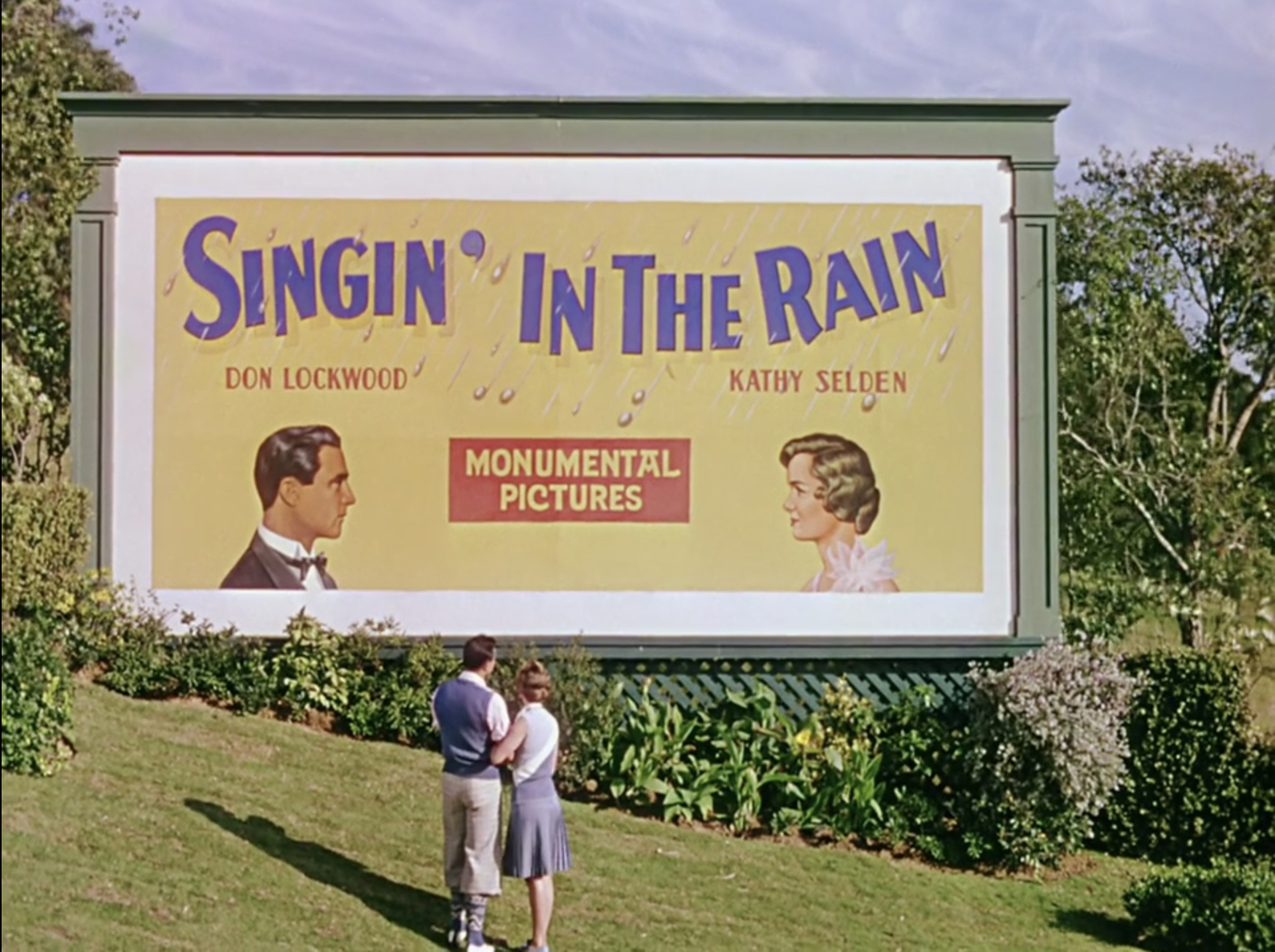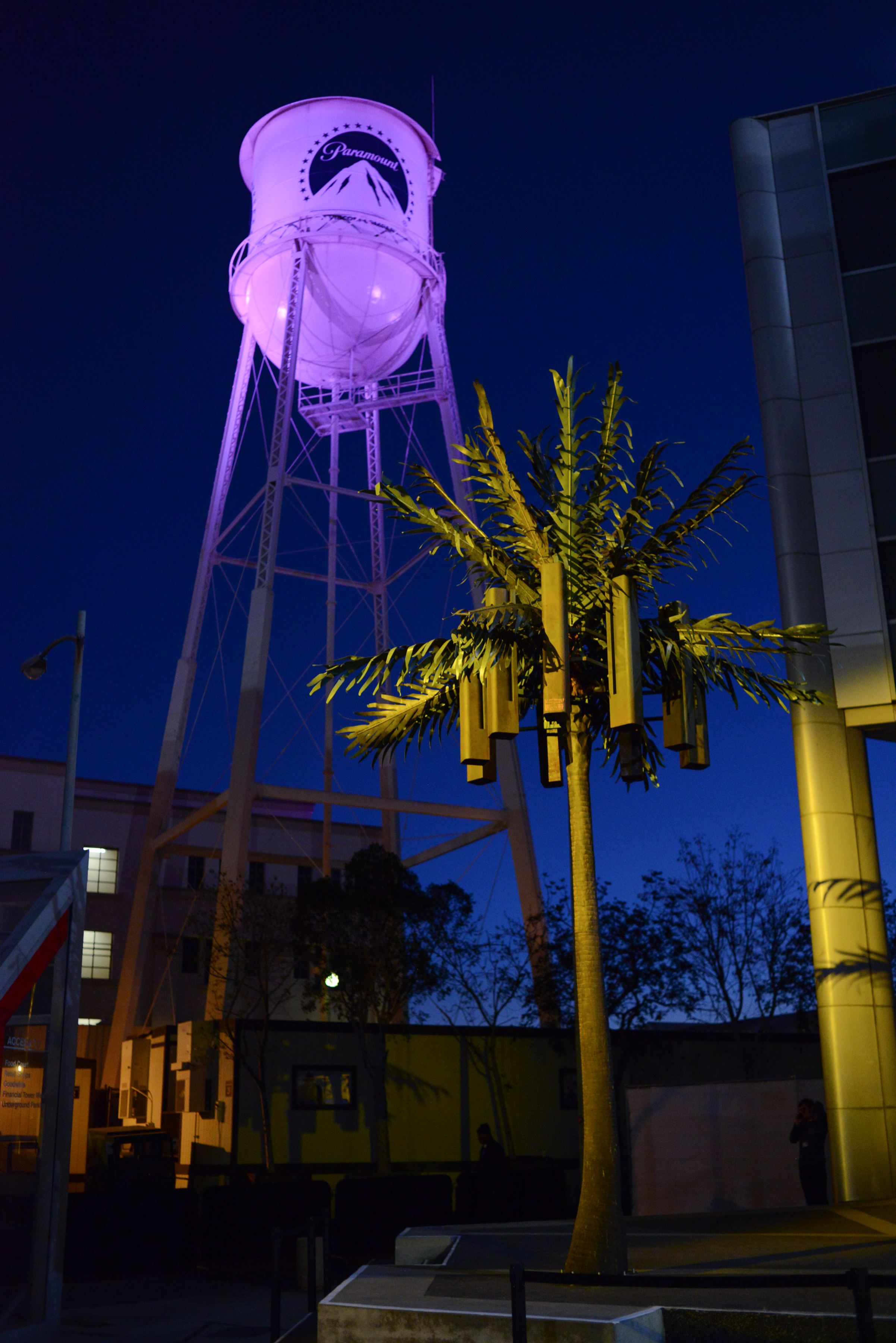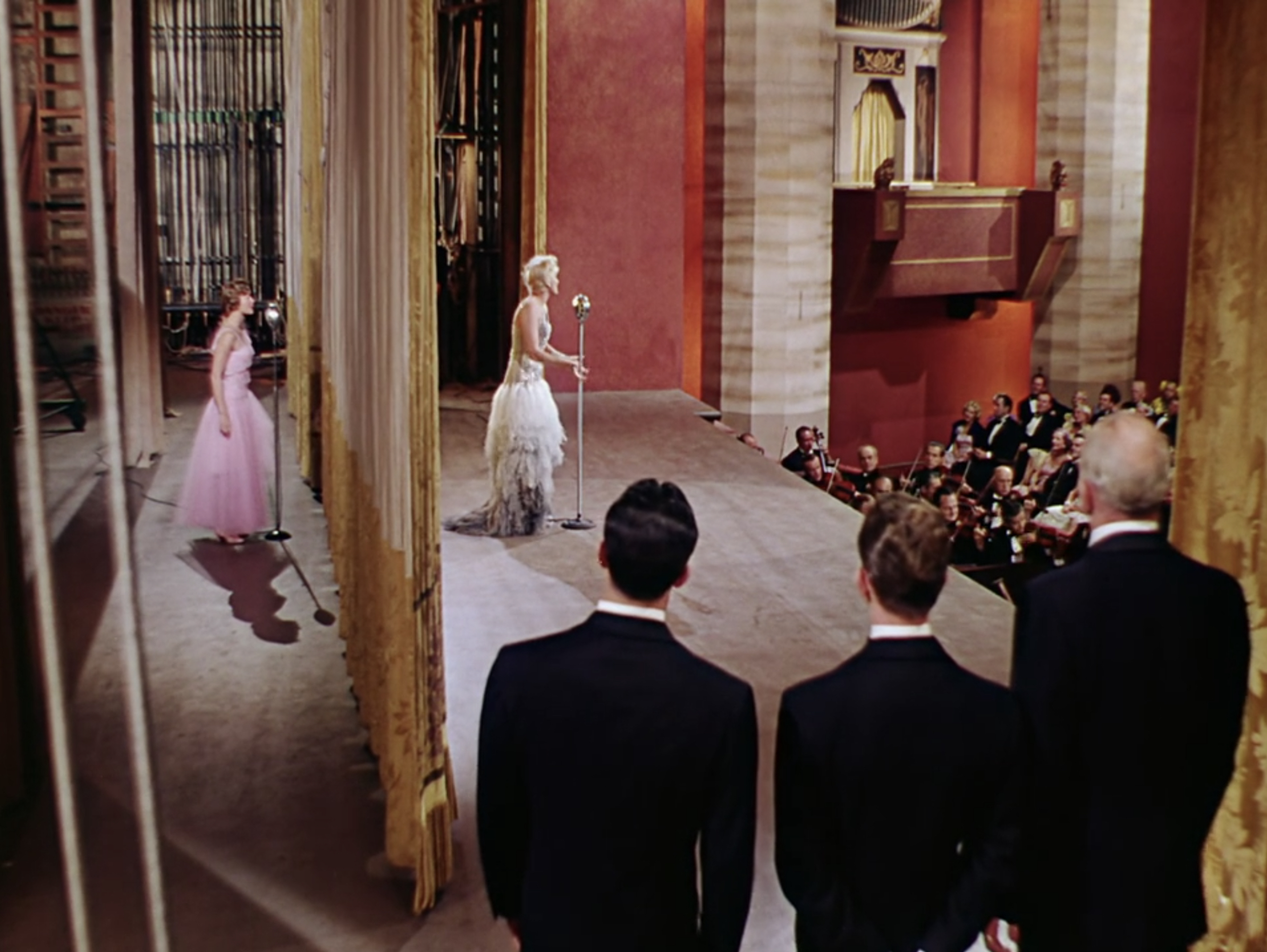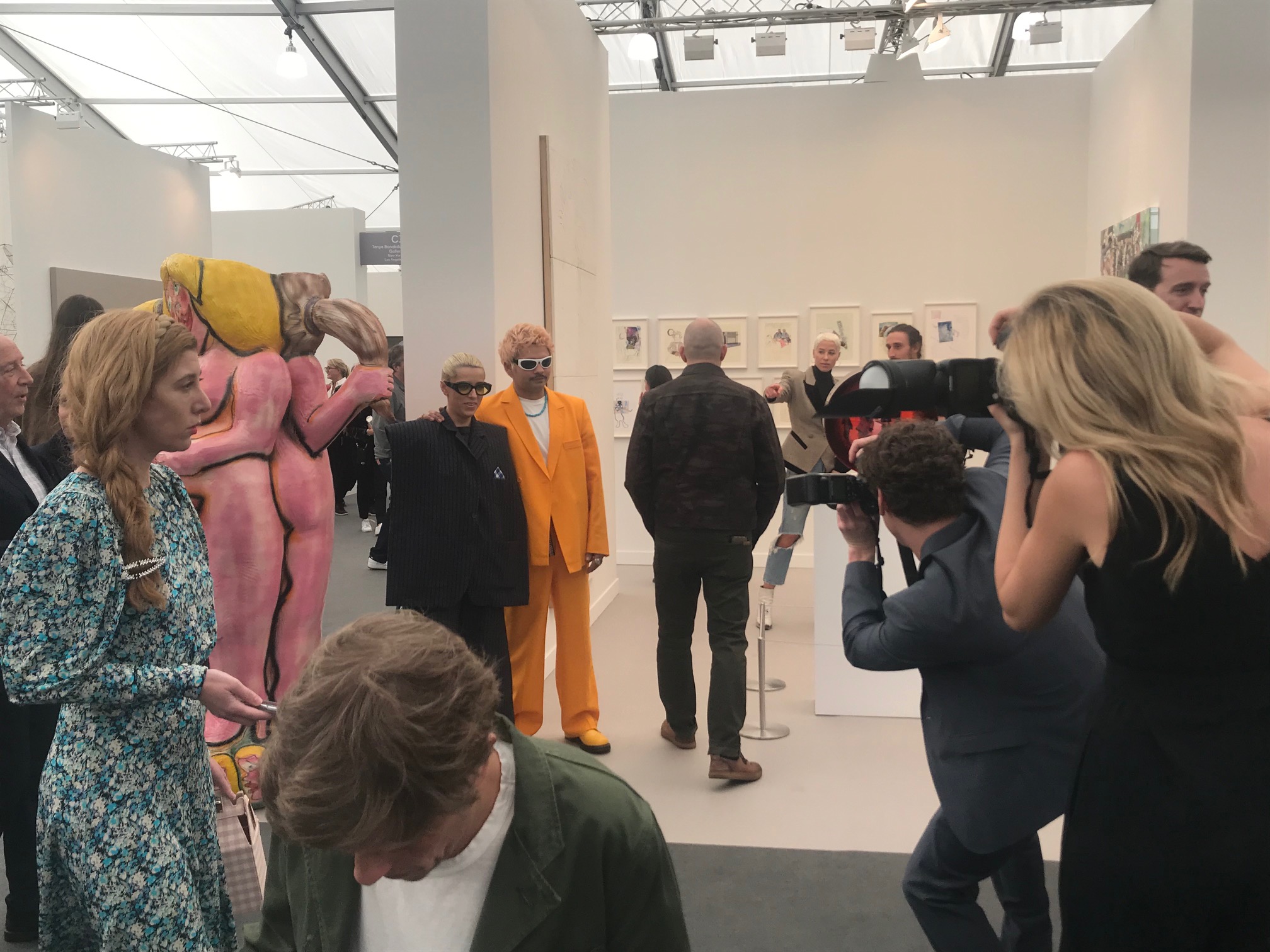“All Done with Mirrors”: On Frieze and Lies in Los Angeles
by Gracie Hadland
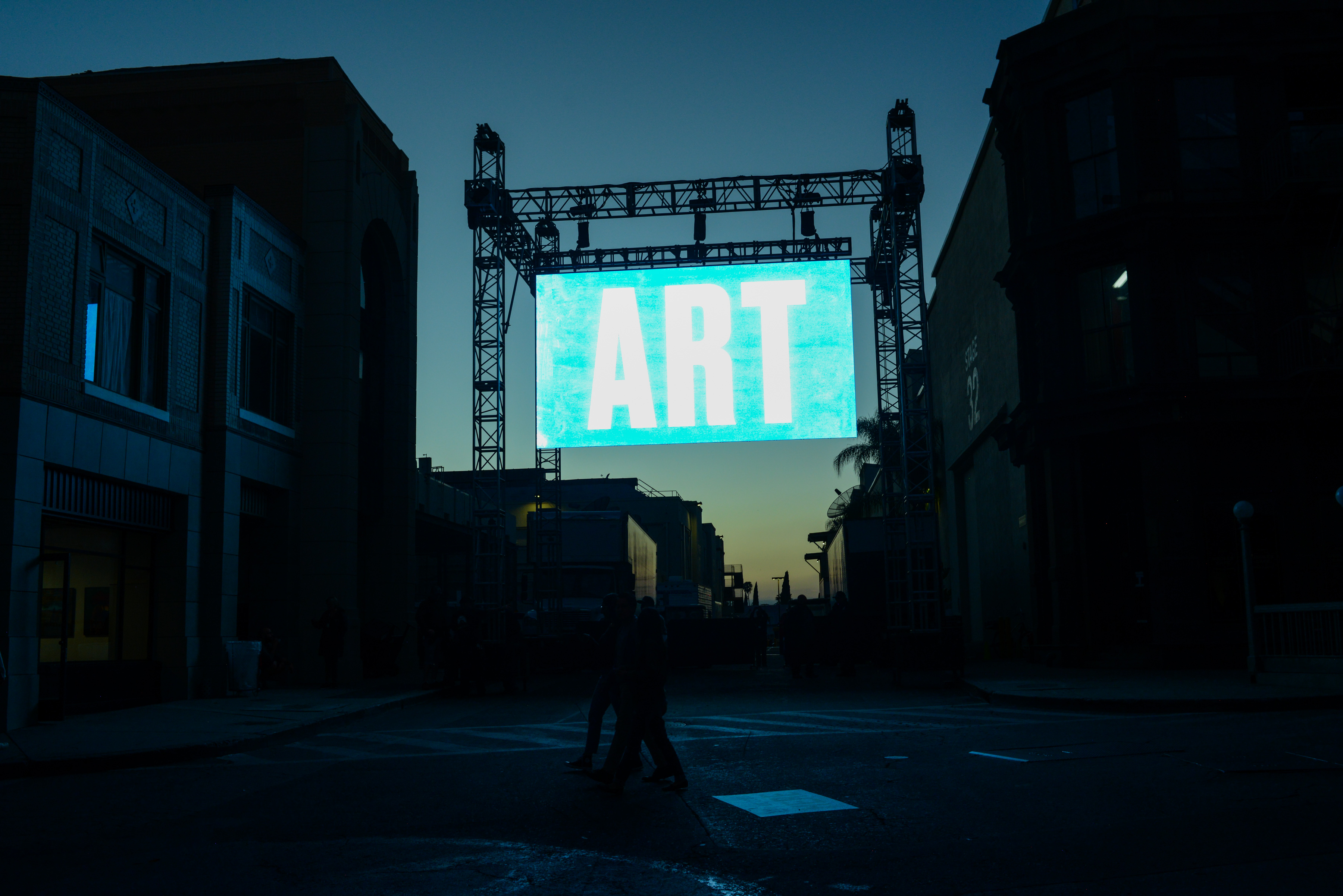
Frieze Los Angeles 2020 at Paramount Pictures Studios in Hollywood. Photo: Casey Kelbaugh courtesy of Frieze.
“But then we’re in real life now, not Hollywood High, and it’s about art and money and Francis Ford Coppola and Paramount.”
— Eve Babitz, “All This and the Godfather Too”
***
In one of the many iconic numbers from MGM’s classic musical comedy Singin’ in the Rain, Donald O’Connor dances around a busy soundstage singing “Make ‘Em Laugh.” Throughout the scene, O’Connor transitions in and out of various sets spanning time periods and genres — a Western, a High School movie, a French Revolution period piece — before arriving at a kind of blank stage, where he opens what appears to be a functioning door and runs into a brick wall. He does a flip on a scrim that looks like a hallway. He flirts with a life-sized, headless dummy filled with cotton. His legs smash through a set made of cardboard and he falls down to the other side. These props which seem operational at first are revealed to be two-dimensional with O’Connor’s musical intervention. Choreographed actors playing gaffers and crew members move about the background of the scene outfitted in 1920s blue collar dress. Presumably, just out of frame are bona fide MGM production crew dressed in contemporary 1950s clothing and working their actual jobs rather than performing them as theater. The distance between onscreen and off is flattened. O’Connor’s star number, like the rest of the film, catalogs these gags and gimmicks, coaxing chuckles from the audience at the onset of the revolutionary new “talking picture” — the ultimate novelty.
Singin’ in the Rain, made in 1952 and set in 1927, is about a new technology supplanting the old — silent films becoming “talkies.” It’s about the anxiety of the modern, the prospect of failure, and the fear of a flop. Debbie Reynolds plays Kathy Seldon, a podunk showgirl who gets her big break as the voice of vain silent film starlet Lina Lamont, whose shrill vocals must be disguised so as not to ruin the reputation of the studio. “We must keep our stars from looking ridiculous at any cost” is the motto of “Monumental Pictures,” MGM’s thinly veiled allusion to Paramount. Tiring of the sham, Kathy eventually threatens to break her contract with Monumental, refusing to go on as the closet voice of Ms. Lamont. But when the audience insists Lina sing them a song at her talkie premiere, Kathy is forced to perform from backstage while a panicked Lina lip-syncs live. The scheme is revealed when a snafu causes the curtains to rise and Kathy runs out of the theater in shame. That’s when the male lead (Gene Kelly) stops the music, points to Kathy, and calls to the audience: “She’s the real star!” Finally, a round of applause for the underdog.
In the world of Monumental Pictures, artifice is essential for business, but it’s the destruction of artifice that triumphs in the end. The exposure of the gimmick marks the film’s joyous conclusion as newcomer Kathy is forever recognized as a talent in her own right. The narrative follows the formula for every Great American Triumph: the protagonist breaks with conformity and expectations in a noble gesture for which they are rewarded in the end. Ultimately, Singin’ in the Rain is about authenticity, Hollywood’s fetish — a desire for what it can never have. But it is a Hollywood movie after all. The attempt to elevate authenticity is futile because the medium is inherently artificial — it has been rehearsed over and over, negotiated and funded, edited, wigs, costumes! Kathy makes a similar argument early on that film acting is just “a lot of dumb show,” while real acting is found in the theater: “Shakespeare, Ibsen!” In the film’s final shot, Gene Kelly and Debbie Reynolds stand in front of a billboard that pictures their faces in profile; the billboard is an advertisement for Monumental’s Singin’ in the Rain. What is suggested here is not completely clear. Is that the film we just watched? Or is it fictional? With this mysterious meta-ending, artifice re-enters the frame and any semblance of authenticity moves further away as the camera pans out.
Singin’ in the Rain, one of the first films I ever saw, loomed over my thoughts during Frieze Los Angeles. In its second west coast iteration, the art fair took place at the historic Paramount Pictures Studios in Hollywood. Top tier galleries set up white box booths in a tent laden with plush carpet at the entrance — the color of the year was a deep pink. Smaller L.A. galleries and artist project spaces occupied the row in the back of the tent. It was what I imagine a convention to be like — fanatics selling wares and displaying their newest oddities in a big civic arena flooded with fluorescent light, albino lizards, and unique species of scorpions. This was an Art Expo, the World Fair. I overheard dealers dealing: “Who do you want to buy?” Overwhelmed by the fanfare, I sought out friends who were on the job checking coats or babysitting art in booths. One was nannying an international dealer’s baby, strapped to his chest in a bjorn.
When I’d first arrived at the fair, a British woman with a posh accent refused to give me a press pass. After I presented my ID and insisted on my due right not to pay the $125 general admission fee, she said, “Yeah, you know I’m not really buying it.” I asked if she thought I was lying (I wasn’t). She shrugged and raised her eyebrows. I’m sure there is a perverse pleasure in being the distributor of VIP badges, just as there is in acquiring one. Lying continued to crop up throughout the weekend.
As I waited for my cred to be validated, I sat outside the security booth watching crew and union guys in cargo shorts drive by in trucks with racks of costumes going to set. I thought of myself channeling Norma Desmond, loitering at the gates of Paramount when she arrives to meet Mr. De Mille in Sunset Boulevard (1950).1Security guards were riding around on bikes with thick tires, the kind I imagine are ubiquitous in utopia. And really Paramount is a sort of utopia, in a disorienting way. To enter the fair, Frieze visitors had to navigate its faux streets, all of which are named as if they could be anywhere in any town. When I asked a security guard how to get to the backlot, she responded, “Go down what we call ‘Main Street,’” implying the obvious, that this is not a real street and this is not a real town.
What sets Frieze Los Angeles apart from other art fairs is its unique setting on a Hollywood studio lot. In this year’s press materials, its logo is embedded into a star on the Walk of Fame. Being unashamed of its relationship to industry and glamour and movies is practically a point of pride for the Los Angeles art world, as if by admitting its own indulgence and frivolity it can set itself apart from older, stodgier art markets in other cities. On the backlot, sets of Manhattan, Brooklyn, and Chicago form a small town, maybe half a mile wide. There is an obviousness in the setting here, which screams, “We’re no New York, but we can get pretty close!” Los Angeles has always had a need to perform as something else, dressing up to be taken seriously but paying no mind when the wig slips off a bit. “We know you know it’s fake,” it seems to whisper, winking. In Thom Andersen’s video essay Los Angeles Plays Itself (2003), Andersen maps the city through spliced clips of movies that cast Los Angeles as a different city, turning a critical eye toward the assertion that Los Angeles, with hardly any history, is nothing more than a Hollywood set — something meant to be produced for profit and entertainment. The cliché goes that the culture of Los Angeles is its culturelessness, in contrast to New York, with its dignified sophistication. But the city’s attempts at east coast mimicry inevitably fall short, crumbling into cheap Dionysian mayhem and leaving Angelenos no choice but to wear its authentic artificiality like a point of civic pride. In fact, referencing its own contrivance is commonplace in most movies about Hollywood. In Sunset Boulevard, another Paramount Pictures feature, Betty Schafer (played by Nancy Olson) strolls around the empty lot and remarks, “Look at this street. All cardboard, all hollow, all phony, all done with mirrors. You know, I think I like it better than any street in the world.”
Special artist projects were installed among Frieze’s “pop-up” bars, cafes, and bookstores in the backlot’s faux storefronts, typically used as background. Shallow in square footage, once you stepped inside these spaces you realized the scale was skewed, the brick was hollow, and the wood unfinished — an optical illusion. Curated by Rita Gonzalez (LACMA) and Pilar Tompkins Rivas (Vincent Price Art Museum), the backlot featured works by Will Boone, Sayre Gomez, Gabriella Sanchez, Gary Simmons, Lorna Simpson, Mungo Thomson, and Naama Tsabar. Some were so well integrated into the simulated metropolis that they were easy to miss. Sayre Gomez’s Tocayo 2020 (2020), a palm tree cell tower, appeared as though it was being used to operate the fair’s cell service. The work addressed its own camouflage in this way, trying to look natural while concealing its artificiality. Works that made these cheeky, complex maneuvers stood out on the lot, or rather blended in, but being inconspicuous in Los Angeles is the more pressing task anyway. Angelenos learn to stare without staring. Talking to someone while simultaneously scanning the room is an essential skill. In The Day of the Locust, yankee artist/west coast transplant Nathanael West describes this trait dramatically, about 80 years before Frieze: “While others moved rapidly, darting into stores and cocktail bars, they loitered on the corners or stood with their backs to the shop windows and stared at everyone who passed.”2
To the same effect as Tocayo 2020, Mungo Thomson’s bronze-casted Amazon packages sat in front of one of the lot’s fake brownstones, complete with the artist’s real home address, I imagine to the concern of his wife. Both works engage in a tongue-in-cheek humor, leaning into the bizarre setting of the fair. The gimmick requires a double take, which is something Angelenos are used to doing anyway, with all the near and promised celeb sightings. “Is that?”…“No, but looks like her.” The experience is always kind of a dead end, a brief moment of skepticism and imagination, but then oh — it’s nothing.
I had one such experience earlier that week at Reena Spaulings Fine Art, a gallery that did not take part in Frieze but hosted an exhibition of paintings by German artist Michael Krebber at the same time. In the gallery’s Instagram post advertising the show, Krebber’s Nike duffle bag appears in front of one of the canvases.3When I arrived at the opening, it was still there. Was it part of the work or had it been forgotten? I asked around and few people seemed to notice. The curator, John Kelsey, said yes and no. Krebber had seen the post, so he brought the duffle to the opening and set it down in the same spot. Kelsey imitated Krebber’s hearty laugh after having done this — another gimmick, one with viewers left wondering is it art or isn’t it, the answer being both yes and no.
Among the alternative fairs to Frieze Los Angeles were Art Los Angeles Contemporary at the Hollywood Athletic Club and Felix at the Hotel Roosevelt. Similar to Frieze but noticeably more relaxed, Felix offered a simulated VIP experience that allowed select visitors to feel like they were in on the secret, privy to a behind-the-scenes exclusive. At the Roosevelt, a line formed to ride the service elevator up to the gallery displays. Prosecco was served on a platter to keep us occupied during the wait. Visitors moseyed through Old Hollywood hotel rooms, where art was installed in the bathrooms and gallerinas lounged with their feet on coffee tables. The art market relies on desire — for exclusivity, for reputation, for the one-of-a-kind — and Felix’s hotel format mimicked an experience of clandestine intimacy, like sneaking off to a jaunt with a lover. Back at Frieze, a friend pointed out a small room beside Kayne Griffin Corcoran that was full of computers, flashing little lights operating James Turrell’s light installation. Fairgoers are made to feel like insiders by their position on the studio lot, exposed to the world behind the curtain, like watching Singin’ in the Rain. Suddenly we’re filmmakers on set, or celebrity guests at the Roosevelt, or members of the Hollywood Athletic Club. But as long as the means of production are obscured, transparency is merely a performance and our access is illusory, another part of the grand production.
Also installed in the backlot was artist Pentti Monkkonen’s The Dollhouse, a speakeasy distributing contraband liquor out of a bar masterfully crafted from thin panels of wood. Jenny of Jenny’s art gallery in Silver Lake served free shots to patrons in the know. Paintings of cigarette boxes and cigar logos adorned the walls, like a real dive bar, but still it felt hollow, timeless, and vacant. The work, which came together last minute and was not advertised in Frieze media, was promptly shut down after someone was reported to be smoking inside. The Dollhouse was small to make you feel big — simultaneously big and small, like the rest of the lot.
When Michael Eisener was head of Paramount from 1976 to 1984, the studio produced American Graffiti, Grease, and Happy Days. Each was a charming return to the chipper post-war era of the 1950s, just as Singin’ in the Rain returned to the glamorous pre-war years of the late 1920s. Nostalgia is another of Hollywood’s fetishes, a kind of investment guarantee. Not surprisingly, every Frieze after-party was hosted at some Old Hollywood haunt — Hotel Roosevelt, Chateau Marmont, Yamashiro, and the like.
Film critic A.S. Hamrah writes that by the late 1970s screenwriter Robert Towne, who penned a number of Paramount pictures, felt that “Hollywood cinema had reached a dead end because there was ‘nothing left to expose’ — every corruption had now been seen in movies.”4The same might be said for the art world. During the run of Frieze Los Angeles, groups of tourists on Hollywood vacations milled about the lot following a tour guide dressed in quaint 1930s pinstripes. When the guide held an iPad to his chest to showcase famous movie scenes filmed on the sets where they were standing, a man turned to the woman next to him and said, “I can’t believe I’m there.”
With the bizarre postmodern setting overshadowing much of the art, the remaining pieces on the backlot appeared more like stage props. Gonzalez and Tompkins Rivas explained in the Frieze Projects press release their idea to bring in a global selection of artists “to work within the archive and legacy of Paramount Pictures Studios, deepening the program’s conversation with its film set location.”5This attempt to engage in conversation with the legacy of Paramount is only superficial. While aesthetic parallels may be made between the art world and Hollywood, their true parallel is more implicitly that their functions as capitalist industries are almost too transparent and they are unable to see the forest for the trees. According to Hamrah, “Eisener, later head of Disney, sent everybody at Paramount a memo that read: ‘We have no obligation to make history. We have no obligation to make art. We have no obligation to make a statement. To make money is our only objective.’”
Mark Shapiro, head of Endeavor, the parent company of Frieze, made an eerily similar statement about this year’s fair: “Sales bring buzz and buzz brings sales. They feed off of each other. If we go to each of the galleries, always after the niceties and talking about the different pieces that are being shown, they immediately get into the results, because for them, beyond everything else, it is a business.”6I assume these “niceties” he refers to means any sort of critical or social engagement with the work — what it means, represents, who the artist is, etc. Essentially the fair, Shapiro posits in his straightforward answer, is a glamorized retail experience for the wealthy.
Really, this is nothing new. Money has always been the ambition of Hollywood, but the art world has mostly attempted to keep quiet about its financial motivations, or at least disguise them as something else. That’s all blown out of the water at Frieze, where the Los Angeles art world leans way into it, aligning itself with artifice, glamour, and the business of Hollywood. Is it all in the name of authenticity? A cathartic confession of its ills? To manufacture transparency in a space so inherently artificial could not be more appropriate (sometimes clichés are true). Displaying itself on a simulacrum of its long-time rival New York, it’s as if Los Angeles (this Los Angeles, there are many) is admitting to its own deficiencies before anyone else can. But the “authenticity” presented is calculated and, in the end, the strategic self awareness performed by both industries is negated by their relationships to capital.
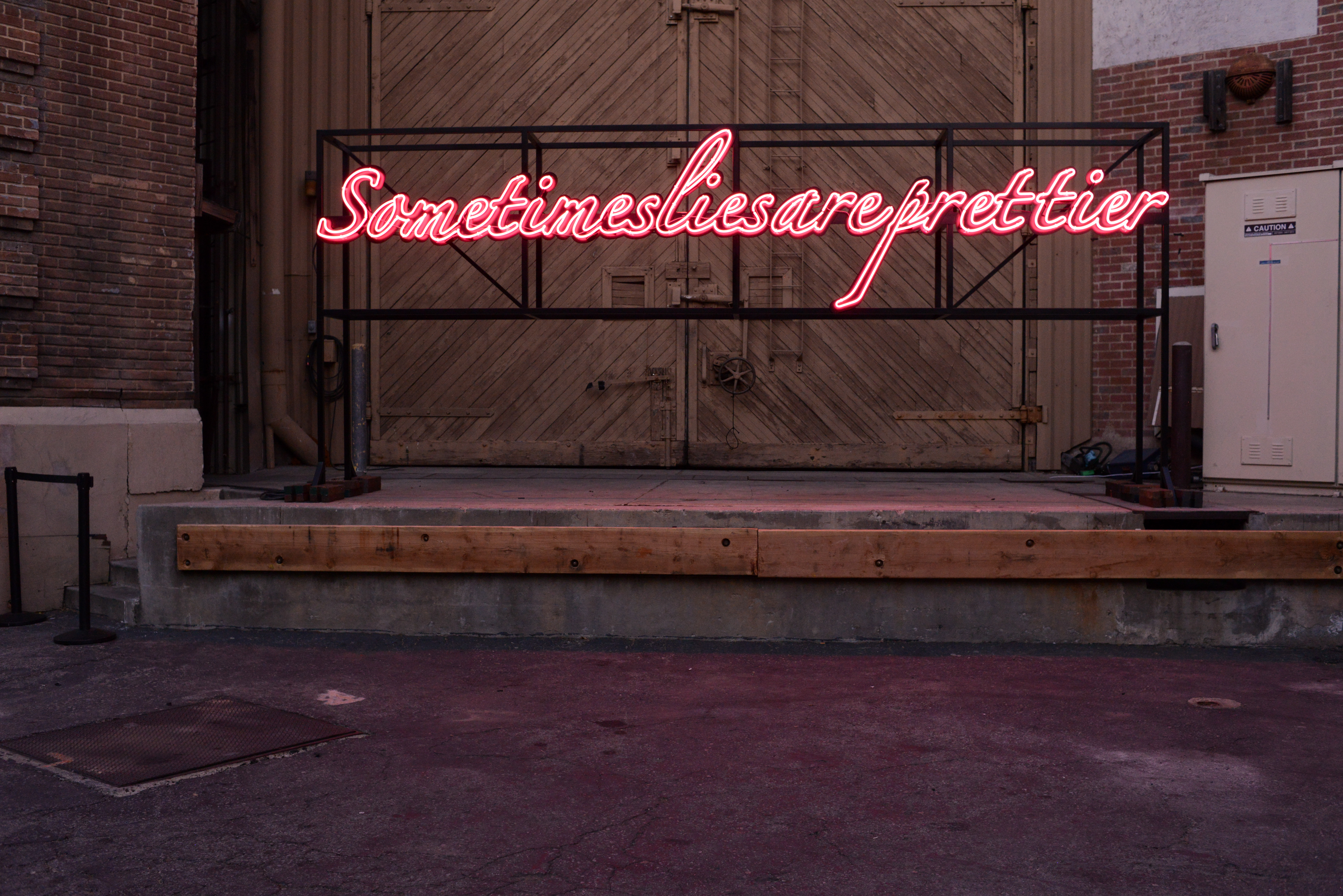
Tavares Strachan, Sometimes Lies Are Prettier, Frieze Los Angeles, 2020. Photo: Casey Kelbaugh courtesy of Frieze.
A week after the fairs I found myself at dinner with the French theorist who edited Baudrillard’s Simulations. We chatted over glasses of red wine and I told him I had just been to Frieze. He was wearing a Captain America t-shirt and in practically a whisper, as if offering me sage advice, he responded, “Everything that’s big is dead.” I nodded in agreement, but wondered what things were still small and alive. I had him autograph my copy of Simulations.
Baudrillard quotes Ecclesiastes in his epigraph to Simulations: “The simulacrum is never that which conceals the truth — it is the truth which conceals that there is none. The simulacrum is true.” What I think Baudrillard is saying is that there’s nothing behind the facade, it’s just that. And if the simulacrum is true, maybe artifice is the closest we get to what’s real at Frieze, a meeting of two monied industries based in the construction of image fantasies. Kenneth Anger, in his book Hollywood Babylon, describes the sordidness of Old Hollywood, the glamour and the violence. Suggesting a parallel between the Hollywood audience and iconoclasts, he writes, “The fans worshipped, but the fans also could be fickle, and if their deities proved to have feet of clay, they could be cut down without compassion.”7Baudrillard writes again of the iconoclasts later in Simulations: “It can be seen that the iconoclasts, who are often accused of despising and denying images, were in fact the ones who accorded them their actual worth, unlike the iconolaters, who saw in them only reflections and were content to verate God at one remove.”8It is the audience that indulges the gimmicks that gives art its place on the pedestal.
The first time I saw a movie in a theater I went to see Singin’ in the Rain at the Stanford in Palo Alto. The theater, built in 1925, played strictly classic Hollywood movies. After the movie ended, I ran up and down the aisles trying to see what was behind the screen. I was 10 years old.
A few weeks after the fair I spoke to my friend Reynaldo Rivera, a photographer who has documented queer nightlife and Latinx drag culture in Los Angeles for over 30 years. He talked about the language of Hollywood as something he learned to speak before English, his second language. Reynaldo has always photographed in cinematic, noir style with the dramatic contrasts of black and whites. He most often photographs queens from different communities and cultural backgrounds, all lusting after the same ephemeral glamour. He insisted to me then that the glamour is real and true if it generates work. Eve Babitz asserts something similar in an essay she wrote on the set of The Godfather: Part II, “And what would I write about if there was no glamour?”9I don’t know.
